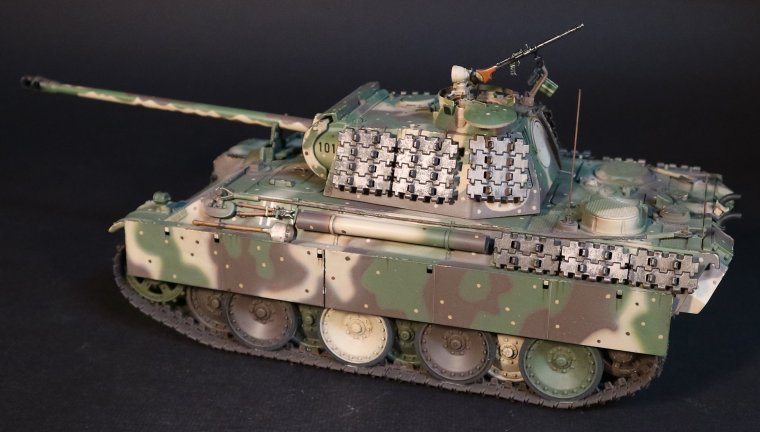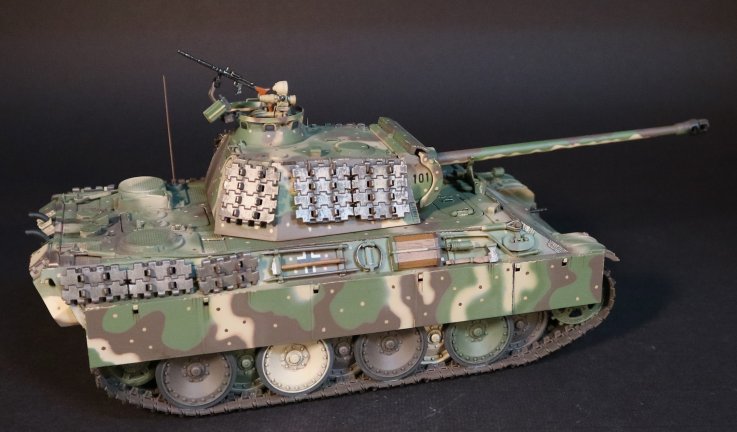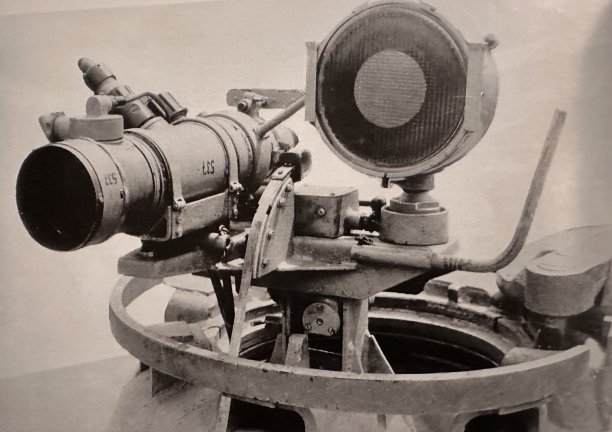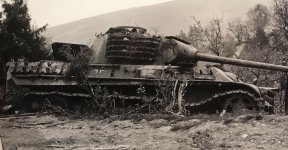- Joined
- Feb 2, 2011
- Messages
- 2,384
NEW RELEASES FOR MAY 2024
THE SECOND WORLD WAR
GERMAN ARMOUR
The Panzerkampfwagen "Panther" was arguably the finest tank design of World War Two. Heavily influenced by combat experience against the Russian T-34 on the East Front, the Panther possessed an excellent balance of firepower, armor protection, and mobility. The Panther's long barreled, high velocity 7.5 cm Kw.K. L/70 cannon possessed greater penetrating power than the 8.8 cm cannon on the Tiger I, and was capable of defeating any Allied tank. This lethality was coupled with excellent frontal armor protection, where the Panther's 80 mm front glacis plate sloped at 55 degrees provided more armor protection than the Tiger I. It was not uncommon for horrified Allied tankers to watch as multiple hits with armor piercing ammunition simply bounced off the Panther. Therefore, Allied tankers usually maneuvered to get shots on the Panther's sides, where the weaker 45 mm turret sides and 40 mm hull sides could be penetrated at normal combat ranges. Finally, the Panther rounded out its outstanding characteristics with excellent mobility. It was powered by the same Maybach engine as the Tiger I and King TIger. However, because it was significantly lighter, the Panther possessed a much higher horsepower to weight ratio than the German heavy tanks. This extra power, coupled with wide tracks that reduced its ground pressure to less than that of a Sherman tank, provided the Panther with excellent cross country mobility.

GA-42
THE SECOND WORLD WAR,
GERMAN ARMOUR,
German Panzerkampfwagen "Panther" Ausf. G (Sd.Kfz.171)
Daimler Benz Factory "Ambush" Camo
Panther #101 of 1. SS-Panzer-Division "LSSAH", SS-Panzer-Regiment 1, Kampfgruppe Peiper
Ardennes Offensive, December 1944.
(22 pcs)
Panther #101 was commanded by Obersturmführer Karl Kremser, the commander of 1. Kompanie, SS-Panzer Regiment 1. Kremser's tank and the 15 Panthers of his Kompanie were near the front of Kampgruppe Peiper's long column, preceded only by the spearhead company and Peiper's own command group, when Kampfgruppe Peiper began its mad dash to cross the Meuse River on 16 December 1944 during Unternehmen Wacht am Rhein (Operation Watch on the Rhine), better known as the Ardennes Offensive or the Battle of the Bulge.

By the afternoon of 17 December, Kremser's tank and a group of Panthers had made good progress and reached Ligneuville. Then, in the early morning of 18 December, Panther #101 and this mixed group of Panthers attacked Stavelot, breaking through the town. Kremser's tank was hit several times by American 57mm anti-tank cannon fire as it was crossing the bridge over the Ambleve River, eventually breaking down when its engine stalled. While still under fire from the American guns, Panther #101 was towed from the bridge by another 1. Kompanie Panther. During this recovery operation, Kremser was wounded in both legs while standing next to his tank, and handed command of both 1. Kompanie and Panther #101 over to Untersturmführer Hennecke, the commander of Panther #111.

After buttssing that Panther #101's main damage was limited to the optics for its 75mm cannon, Hennecke switched out the optics from another Panther outside Stavelot and continued behind the rest of the Panthers of 1. Kompanie. Making progress, Panther #101 was near the bridge at Cheneaux when Kampfgruppe Peiper came under repeated attack by American fighter-bombers. Surviving this attack, Panther #101 continued on with the Kampfgruppe to La Gleize. Here, the Panther went into position south of La Gleize's town hall, where Hennecke set up the command post for 1. Kompanie. At this time, due to the small number of operational tanks and because Hennecke was in charge of the command post, he turned over Panther #101 to a non-commissioned officer from 3. Zug (platoon). Panther #101 remained in this position and resisted American attacks on La Gleize until it was abandoned by its crew late on 23 December 1944, when Peiper decided to abandon the surrounded town and break out on foot with what remained of his troops.

The John Jenkins Designs Panther #101 was produced by the Daimler Benz assembly firm in the fall of 1944. It is painted in the iconic "Ambush" or "Licht und Shatten" (Light and Shadow) camo pattern with contrasting dots unique to the Daimler Benz assembly firm. Two other unique features of Panthers assembled by Daimler Benz were 1) the location of the Balkenkreuz (German national symbol), which were placed under the tool racks on the left forward and right center hull sides, and 2) the camo pattern on the rear hull was also painted over the extra track links mounted to the hull sides. Lastly, the track links on Panther #101's turret sides are displayed in a non-standard fashion, with the track teeth pointing inward. It's theorized that this was done by Kremser, who was a veteran, to provide more stand-off distance and protection from enemy shaped charges like those in bazooka rockets.

Additionally, Panther #101 displays unit specific markings of SS-Panzer Regiment 1 during the Battle of the Bulge. The side turret numbers are white outlined, black numbers where the stencil markings have not been completely painted in with white. Additionally, because these turret numbers were usually hidden by track links, small black turrey numbers were also painted on the sides of the cannon's mantlet and on the upper left rear of the turret.
Panther #101 adds another historic tank from Kampfgruppe Peiper and pairs perfectly with the previously released King Tigers and Sd.Kfz. 251 halftracks to form a historically accurate battle group display.
Finally, in a nod to historians who like to ponder how small changes could have led to different outcomes in battles, Panther #101 comes with a "what if" accessory: the German F.G. 1250 Ziel - und Kommandanten - Optik fuer Panther (Commander's Infrared Searchlight and Scope for the Panther). The F.G. 1250 was a combination 200-watt infrared searchlight coupled with a receiver scope/gunsight that had a range of 600 meters at night in clear weather. The Germans envisioned an infrared equipped Panther as just one component of an integrated night fighting unit. Infrared scopes were also developed for the Sd.Kfz. 251 halftrack's driver and MG-42 gunner along with a significantly larger infrared searchlight fitted to a dedicated 251 halftrack (named Uhu, or Owl) that would provide wider infrared area illumination. The Germans also developed a dedicated infrared system for individual soldiers, whereby a battery backpack was worn that provided power for an infrared searchlight/scope mounted to an MP-44 assault riffle (known as Vampyre).

The development of German infrared night-fighting technology was coming to fruition in the fall of 1944. Starting in September 1944, orders were given to begin fitting F.G. 1250s to a limited number of Panthers. Because of the top-secret, cutting edge nature of this technology, the Germans were very wary of it being captured in combat. Consequently, while Infrared equipped Panthers were produced and fought in combat, there are no known cases of the F.G. 1250 sight or other German infrared scopes actually being used in combat. Some of the critical decisions by Kampfgruppe Peiper and other Panzer divisions during the Battle of the Bulge were to not launch night attacks at critical bridge crossings (like at Stavelot), and instead wait for morning attacks. Had the Germans been able to field infrared night vision equipment prior to the Battle of the Bulge, it's possible the battle could have gone much differently. Luckily for the world, like most all of the Third Reich's Wunderwaffe (Wonder Weapons), infrared night fighting capability was developed too late and in insufficient numbers to alter the course of the war.

The John Jenkins Designs Panther #101 also comes with the following features:
- all turret hatches open, including the rear turret escape hatch
- detailed turret and hull interior
- opening engine hatch with detailed engine
- removable schürzen side skirts
- commander's cupola mounted anti-aircraft machine gun
Many thanks once again to “Hunter Rose”.
** PLEASE CONTACT YOUR LOCAL DEALER FOR FURTHER INFORMATION**
THE SECOND WORLD WAR
GERMAN ARMOUR
The Panzerkampfwagen "Panther" was arguably the finest tank design of World War Two. Heavily influenced by combat experience against the Russian T-34 on the East Front, the Panther possessed an excellent balance of firepower, armor protection, and mobility. The Panther's long barreled, high velocity 7.5 cm Kw.K. L/70 cannon possessed greater penetrating power than the 8.8 cm cannon on the Tiger I, and was capable of defeating any Allied tank. This lethality was coupled with excellent frontal armor protection, where the Panther's 80 mm front glacis plate sloped at 55 degrees provided more armor protection than the Tiger I. It was not uncommon for horrified Allied tankers to watch as multiple hits with armor piercing ammunition simply bounced off the Panther. Therefore, Allied tankers usually maneuvered to get shots on the Panther's sides, where the weaker 45 mm turret sides and 40 mm hull sides could be penetrated at normal combat ranges. Finally, the Panther rounded out its outstanding characteristics with excellent mobility. It was powered by the same Maybach engine as the Tiger I and King TIger. However, because it was significantly lighter, the Panther possessed a much higher horsepower to weight ratio than the German heavy tanks. This extra power, coupled with wide tracks that reduced its ground pressure to less than that of a Sherman tank, provided the Panther with excellent cross country mobility.

GA-42
THE SECOND WORLD WAR,
GERMAN ARMOUR,
German Panzerkampfwagen "Panther" Ausf. G (Sd.Kfz.171)
Daimler Benz Factory "Ambush" Camo
Panther #101 of 1. SS-Panzer-Division "LSSAH", SS-Panzer-Regiment 1, Kampfgruppe Peiper
Ardennes Offensive, December 1944.
(22 pcs)
Panther #101 was commanded by Obersturmführer Karl Kremser, the commander of 1. Kompanie, SS-Panzer Regiment 1. Kremser's tank and the 15 Panthers of his Kompanie were near the front of Kampgruppe Peiper's long column, preceded only by the spearhead company and Peiper's own command group, when Kampfgruppe Peiper began its mad dash to cross the Meuse River on 16 December 1944 during Unternehmen Wacht am Rhein (Operation Watch on the Rhine), better known as the Ardennes Offensive or the Battle of the Bulge.

By the afternoon of 17 December, Kremser's tank and a group of Panthers had made good progress and reached Ligneuville. Then, in the early morning of 18 December, Panther #101 and this mixed group of Panthers attacked Stavelot, breaking through the town. Kremser's tank was hit several times by American 57mm anti-tank cannon fire as it was crossing the bridge over the Ambleve River, eventually breaking down when its engine stalled. While still under fire from the American guns, Panther #101 was towed from the bridge by another 1. Kompanie Panther. During this recovery operation, Kremser was wounded in both legs while standing next to his tank, and handed command of both 1. Kompanie and Panther #101 over to Untersturmführer Hennecke, the commander of Panther #111.

After buttssing that Panther #101's main damage was limited to the optics for its 75mm cannon, Hennecke switched out the optics from another Panther outside Stavelot and continued behind the rest of the Panthers of 1. Kompanie. Making progress, Panther #101 was near the bridge at Cheneaux when Kampfgruppe Peiper came under repeated attack by American fighter-bombers. Surviving this attack, Panther #101 continued on with the Kampfgruppe to La Gleize. Here, the Panther went into position south of La Gleize's town hall, where Hennecke set up the command post for 1. Kompanie. At this time, due to the small number of operational tanks and because Hennecke was in charge of the command post, he turned over Panther #101 to a non-commissioned officer from 3. Zug (platoon). Panther #101 remained in this position and resisted American attacks on La Gleize until it was abandoned by its crew late on 23 December 1944, when Peiper decided to abandon the surrounded town and break out on foot with what remained of his troops.

The John Jenkins Designs Panther #101 was produced by the Daimler Benz assembly firm in the fall of 1944. It is painted in the iconic "Ambush" or "Licht und Shatten" (Light and Shadow) camo pattern with contrasting dots unique to the Daimler Benz assembly firm. Two other unique features of Panthers assembled by Daimler Benz were 1) the location of the Balkenkreuz (German national symbol), which were placed under the tool racks on the left forward and right center hull sides, and 2) the camo pattern on the rear hull was also painted over the extra track links mounted to the hull sides. Lastly, the track links on Panther #101's turret sides are displayed in a non-standard fashion, with the track teeth pointing inward. It's theorized that this was done by Kremser, who was a veteran, to provide more stand-off distance and protection from enemy shaped charges like those in bazooka rockets.

Additionally, Panther #101 displays unit specific markings of SS-Panzer Regiment 1 during the Battle of the Bulge. The side turret numbers are white outlined, black numbers where the stencil markings have not been completely painted in with white. Additionally, because these turret numbers were usually hidden by track links, small black turrey numbers were also painted on the sides of the cannon's mantlet and on the upper left rear of the turret.
Panther #101 adds another historic tank from Kampfgruppe Peiper and pairs perfectly with the previously released King Tigers and Sd.Kfz. 251 halftracks to form a historically accurate battle group display.
Finally, in a nod to historians who like to ponder how small changes could have led to different outcomes in battles, Panther #101 comes with a "what if" accessory: the German F.G. 1250 Ziel - und Kommandanten - Optik fuer Panther (Commander's Infrared Searchlight and Scope for the Panther). The F.G. 1250 was a combination 200-watt infrared searchlight coupled with a receiver scope/gunsight that had a range of 600 meters at night in clear weather. The Germans envisioned an infrared equipped Panther as just one component of an integrated night fighting unit. Infrared scopes were also developed for the Sd.Kfz. 251 halftrack's driver and MG-42 gunner along with a significantly larger infrared searchlight fitted to a dedicated 251 halftrack (named Uhu, or Owl) that would provide wider infrared area illumination. The Germans also developed a dedicated infrared system for individual soldiers, whereby a battery backpack was worn that provided power for an infrared searchlight/scope mounted to an MP-44 assault riffle (known as Vampyre).

The development of German infrared night-fighting technology was coming to fruition in the fall of 1944. Starting in September 1944, orders were given to begin fitting F.G. 1250s to a limited number of Panthers. Because of the top-secret, cutting edge nature of this technology, the Germans were very wary of it being captured in combat. Consequently, while Infrared equipped Panthers were produced and fought in combat, there are no known cases of the F.G. 1250 sight or other German infrared scopes actually being used in combat. Some of the critical decisions by Kampfgruppe Peiper and other Panzer divisions during the Battle of the Bulge were to not launch night attacks at critical bridge crossings (like at Stavelot), and instead wait for morning attacks. Had the Germans been able to field infrared night vision equipment prior to the Battle of the Bulge, it's possible the battle could have gone much differently. Luckily for the world, like most all of the Third Reich's Wunderwaffe (Wonder Weapons), infrared night fighting capability was developed too late and in insufficient numbers to alter the course of the war.

The John Jenkins Designs Panther #101 also comes with the following features:
- all turret hatches open, including the rear turret escape hatch
- detailed turret and hull interior
- opening engine hatch with detailed engine
- removable schürzen side skirts
- commander's cupola mounted anti-aircraft machine gun
Many thanks once again to “Hunter Rose”.
** PLEASE CONTACT YOUR LOCAL DEALER FOR FURTHER INFORMATION**



